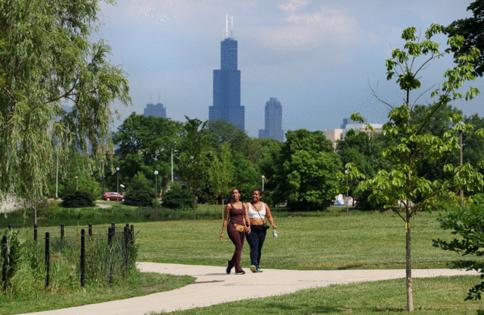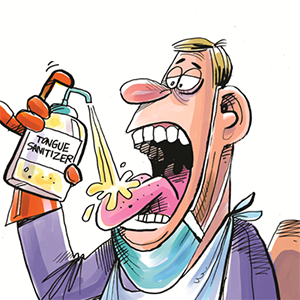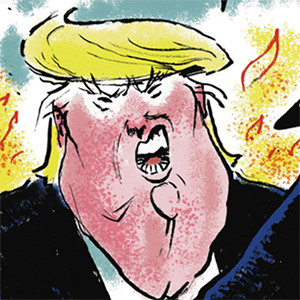Heat wave's high humidity raises health risks in Chicago and across the country
Published in News & Features
CHICAGO — Hot, steamy air blowing into Illinois from a heat dome moving east across the country has kicked off at least a week of dangerous heat, with humidity peaking Saturday through Monday. These kinds of sticky temperatures with little to no overnight relief can pose a major to extreme risk to the health of anyone without access to effective cooling or adequate hydration.
The National Weather Service has forecast daytime temperatures in the Chicago area will reach highs in the low to mid-90s beginning Saturday and early into the week, while humidity will make several days in a row feel like at least 100 degrees. Nighttime temps will be in the low to upper 70s, but it might feel as hot as 90 degrees.
“The temperatures themselves aren’t even that impressive,” said Trent Ford, the Illinois state climatologist.
But that’s dangerous, because people don’t take this kind of heat as seriously as they should.
“Some folks may look at the high temperatures and say — ‘Oh, it’s only going to be in the 90s. It’s not in the hundreds. That won’t feel that bad,'” said Brett Borchardt, a senior meteorologist at the National Weather Service office in Chicago. “It’s really the humidity where public health experts start to notice that there’s more of an impact.”
Heat indices — a combination of atmospheric temperatures and relative humidity to determine how the heat really feels to the body — could be “potentially record-breaking” as they extend from Kansas City to Maine, Ford said.
“The intensity of the humidity is going to be really, really something,” he said. “It has the potential to have more health effects than other, in-your-face heat waves.”
On Sunday, wind gusts of over 30 miles an hour will combine with the heat and humidity to make it almost “feel like a furnace” outside, according to Borchardt.
Human-made climate change is making summers in the Midwest more humid overall, even as seasonal highs have rarely broken records in recent years. According to experts, sweltering summer nights, in particular, have become more common. Such will be the case Saturday through Monday.
“Those overnight low temperatures are going to be close to record values,” Bordchardt said. In Chicago, that record is in the mid- to upper 70s for June. “And that does speak to the magnitude of the heat coming in.”
While dry conditions drive up temperatures dramatically, moist air keeps them a bit lower but makes the heat feel worse to humans. Sunday temperatures were made at least three times more likely by climate change in most of Illinois, according to climate science nonprofit Climate Central.
The heat wave is forecast to last for two weeks across most of the country. Often, during an extremely hot stretch, humidity will spike for a day or two — but this time, it will remain “bad, consistently, every single day,” Ford said.
Moist heat that persists over a long stretch can be particularly dangerous without access to air conditioning. In Chicago, advocacy groups have complained about cooling centers closing to the public over holidays and weekends, even during a heat wave. For instance, all of the city’s public library locations and five of its six official cooling centers were closed to the public in observance of Juneteenth last year during a string of 90-degree days.
According to the Chicago Office of Emergency Management and Communications, 140 locations will be open as cooling centers from Saturday through Tuesday. These centers are a mix of buildings such as public libraries, police stations and community centers, and they are open on different days during this period. Only one of the city’s official cooling centers will be open this weekend.
Though these city buildings are listed as cooling centers during heat waves, many of them aren’t well prepared to serve residents seeking safety from dangerous heat, said Julie Dickinson, an organizer with the Extreme Weather Planners of Chicago, a volunteer group of medical professionals and advocates for unhoused and disabled people that has been working with aldermen to help improve cooling center services.
“None of them are even set up to be really cooling or warming centers,” Dickinson said. “Those places should have cold water. They should have cots to let people rest. They should have chairs set out. They should have signage saying that this is a cooling center.”
These centers also close overnight, even in extreme weather conditions. For people who don’t have access to shelter or air conditioning, not having a cool space to rest overnight can worsen the potential health impacts of extreme heat exposure.
“At night, everyone’s body tries to come back to equilibrium and rest. But during heat waves, you’re taking away a restful night’s sleep, and compounding the issues of dehydration. That’s when we see more people heading into the ER,” said Stephen Koruba, an advanced nurse practitioner of street medicine who works for an outreach project through University of Illinois at Chicago Medical Center.
Hospitals are not immune to the strains of intense heat. Earlier this week, Weiss Memorial Hospital had to evacuate its inpatient unit after its aging air conditioning system failed — and which might not get fixed for two weeks.
Why is it so humid?
Just like greenhouse gases trap heat, moisture holds onto heat in the atmosphere. Rising temperatures, in turn, lead to rising humidity. For every 1.8-degree Fahrenheit increase in temperature, the atmosphere can hold 7% more water. It’s a never-ending loop.
During dry weather, cooler morning temperatures rise as the sun comes up and drop as soon as it sets. But when it’s humid and the atmosphere is waterlogged, temperatures can already be high early in the day. They do not spike as much when the sun comes out, or drop much after it sets, when clouds absorb heat from the surface and emit it back toward the ground in the evening.
A curious contributor to humidity in Illinois air is corn sweat: Rising average temperatures from climate change are increasing the rates at which its millions of acres of corn crops release water vapor into the atmosphere as they mature in the summer and saturate the air with moisture. For context, 1 acre of corn can release 3,000 to 4,000 gallons of water daily, and Illinois planted 10.8 million acres of the crop in 2024.
In Chicago, overall summer average temperatures have warmed by 1.7 degrees between 1970 and 2024, but that’s not the whole story: Average lows on summer nights have increased by 2.5 degrees in that same time.
When talking about heat waves, high temperatures and heat indices “get all the attention,” Borchardt said. “But those overnight low temperatures are really dangerous because it’s difficult to really get any relief when the lows are that warm.”
The coolest part of the night is typically right before daybreak, Borchardt said. And at least during the first few days of this hot stretch, heat indices could be closer to 80 degrees — about the same as the air temperature.
“But that’s still very uncomfortable,” he pointed out.
Why is humid heat so bad?
Both at daytime and nighttime, water vapor in the air makes it harder for people to sweat efficiently enough to cool down. Sweating can be a nuisance, but it’s how human bodies keep cool, regulate their temperature and release moisture, which then evaporates.
This is why exercising outside on a muggy summer day can feel much worse and sweaty than doing so on a similarly hot but dry day. The evaporation of moisture on skin — sweating — happens more easily in dry environments because, in humid environments, water already saturates the air, slowing the process.
Humidity impairs the body’s ability to release heat, more so in older people, said Dr. Rene Roberts, family medicine physician at Oak Street Health.
“As we age, the body changes. And in older adults, the ability to regulate body temperature is a lot more challenging,” she said. “We tend to lose a lot of skin surface mass that allows us to use evaporative cooling — when we sweat to help bring our body temperature down. The ability to even sweat is impaired. As we get older, we don’t have as many sweat glands, and that can make it harder for us to cool our bodies as well.”
People who are over 65 are especially at risk. “When we’re younger, when we’re in our 20s and 30s, a fun day out in the sun may not seem like a big deal, but that can actually turn pretty deadly for someone who is in their 70s and 80s,” Roberts said.
The sticky, persisting humidity makes nights hotter, which can also have serious health implications as it extends human exposure to uncomfortable temperatures.
The threshold for what residents of a certain location consider to be a hot night depends on how acclimatized they are to heat. For example, residents of southern and Gulf of Mexico states experience heat differently from Chicagoans. Generally, however, weather experts say most people don’t need cooling to be comfortable indoors when outside temperatures are under 65 degrees.
“The high heat definitely makes it challenging during the day just to carry out your daily activities,” Roberts said. “And the same can hold true at nighttime, especially if people do not have access to air conditioning.”
Higher nighttime temperatures can lead to insufficient or poor, restless sleep, which can compromise the immune system, increase the risk for cardiovascular disease and diminish cognitive performance. Heat-related illnesses like heat stroke, which occurs when the body can no longer control its temperature, can also be fatal.
Chronic health conditions in older adults that entail difficulties with blood circulation, such as hypertension, diabetes and kidney disease, can lead to the development of heat-related illness if not caught early enough, Roberts said.
“Illnesses related to extreme heat,” she added, “can sneak up on you pretty quickly. Sometimes you don’t even realize it’s happening until you’re in the midst of it.”
Beat the heat
Health and weather experts are urging the public to take the stretch of hot, humid weather seriously.
“We only get like three months of summer here in Chicago, so most people are trying to go out and take advantage of that,” Roberts said. “It sounds good, in theory, to spend a lot of time outdoors.”
But there are times of day that are better suited for safe outdoor enjoyment. The sun’s rays are usually most intense between 10 a.m. and 4 p.m. To avoid the worst of the heat, residents can head out earlier in the morning or push back some activities to later in the day.
For those who’d prefer to stay indoors, air conditioning is a “game-changer,” Roberts said. “It’s something that sounds simple, and we take it for granted.”
She suggests closing curtain blinds from early on in the day to block out any heat from the sun outside. Also, because hot air rises in a building, people living on higher floors in condos or apartment buildings should be mindful of their homes getting too warm, as compared to ground-level, garden or basement units.
And, of course, hydration is key.
“But with water,” she said. “Yes, people want to partake in summertime beverages, maybe indulge in alcohol, lemonade, sweet tea. And (these drinks) may be wet, but they do not replace the benefits of plain water.”
Health experts also encourage residents to check in with their loved ones — parents, older adults, neighbors and vulnerable people — to make sure they’re safe.
“It’s important to remember that this is a health emergency,” Roberts said. “Extreme heat is definitely a health emergency. It should also be, I feel, a public health priority. Because heat-related illnesses are preventable.”
____
©2025 Chicago Tribune. Visit at chicagotribune.com. Distributed by Tribune Content Agency, LLC.







Comments